Sifting is used to separate different materials by means of air-flow. Air separation was first used to separate single-component materials into different particle sizes: for example, air separators are used in the cement industry's milling/classification operations owing to the fineness of the material. A distinction must also be drawn between a dynamic and a static separator: with the former, the force competing with the air-flow is generated by a centrifugal field whereas the latter uses gravity. This article concerns itself solely with sorting into light and heavy fractions using static separators
Wind-sifting represents the separation of a mixture of materials in an air-flow. A major factor is the stationary sinking rate, ie the velocity of a particle in free-fall under the influence of gravity (FG) and the resistance force (FW) caused by the air-flow. The stationary sinking rate depends on the size of the particles, their density and their shape. The following can be stated:
If density and particle shape are identical, the material can be separated according to particle size. This grading or particle size separation process will not be considered in this article.
If particle size and shape are identical but the density is different, then material is separated according to density. Lighter material is entrained by the air while heavier material sinks downwards, contrary to the air-flow.
If particle size and density are identical, the shape of the particle influences the separation process. Particles that are fibrous or have a large surface area are entrained by the air, whereas voluminous, round or cube-shaped particles fall downwards.
In practice, small, heavy components will enter the light fraction while very large, compact, lighter components will join the heavy fraction as 100% separation is generally not possible with inhomogeneous, multi-component materials. Where material changes, however, it should be possible to mount a flexible response in terms of the separation equipment used.
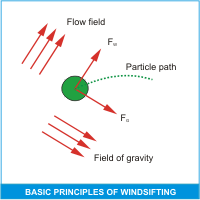 Design of windsifters
Design of windsiftersWhere a heavy fraction is discharged against the direction of air-flow, then this constitutes a counter-flow separator. If heavy fraction discharge is diagonal to the air-flow, then this represents a cross-flow separator. Counter-flow separators include zig-zag separators, pipe separators and conical separators while cross-flow separators are defined according to the criteria by which heavy material and fluff are separated from each other. Ventilatorenfabrik Oelde of Germany uses counter-flow zig-zag separators and, in some special cases, pipe separators. Cross-flow separators are usually equipped with a rotating drum which supports the air-stream in the separation equipment. In individual cases, simple separation plates are used to separate heavy materials and fluff.
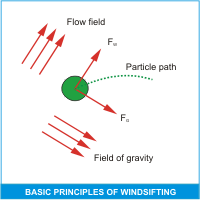
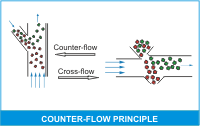
 Construction of windsifter plants
Construction of windsifter plantsA windsifter plant consists principally of a separator housing in which the material is separated by means of air-flow. Another major component is the fan for generating the required air volume; nowadays, this comes equipped with a frequency converter to enable adjustment of the separation velocity in the housing. In addition to infeed and discharge equipment such as feed locks and rotary air-locks under the separator housing, another important component is the discharge device for separating the light fraction from the air-flow. The plant also includes ducting, support structures and any necessary discharge air treatment equipment. As already mentioned, the heavy fraction is discharged from the separator housing without entraining air. Mechanical equipment - such as conveyor belts, rotary air-locks, etc - can be used for this purpose. Fluff is discharged from the separator housing and has to be split from the separation air in the corresponding separator. Three different separator types can be used: the expansion plenum, the aero-cyclone and the so-called fluff separator.
Separator for light-fraction discharge
Sizing of these separators is of major importance to the entire separation process. For this reason, it is appropriate to emphasise a few points about the different separator systems.
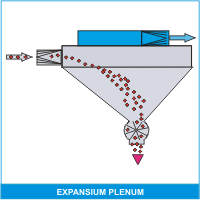
Expansion plenum
In the expansion plenum, the air together with the entrained material is expanded in a very large vessel. This causes the air to lose its energy content and the material can be discharged at the base through a rotary air-lock. Advantages include its simple format and favourable price, while disadvantages are the control sensitivity of the equipment with regard to the zero pressure point, its relatively narrow range of function and its large size
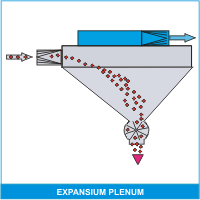
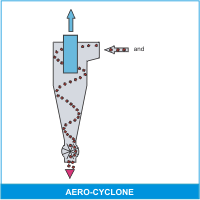
Aero-cyclone
In the aero-cyclone, air and entrained material tangentially enter the hopper-shaped vessel. The air firstly moves downwards in two eddies and then upwards in the direction of the immersion pipe. Centrifugal forces press the material against the outer wall and it is then discharged from the cyclone separator through rotary air-locks at the base. The cleaned air exits through the immersion pipe and the clean air outlet. The advantages of this piece of equipment include simple construction and relatively low price, while disadvantages are its enormous height and the risk of blockages caused by the conical hopper shape. Furthermore, a cyclone separator has a narrow function range with regard to the air-flow rate.
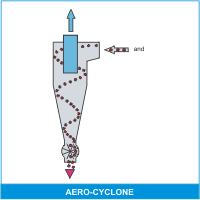
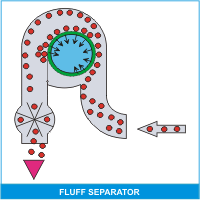
Fluff separator
In light of the above, Ventilatorenfabrik Oelde has developed a special separator which facilitates separation of the material from entraining air. The air stream bearing the material tangentially enters a volute casing inside which rotates a perforated drum. On the one hand, centrifugal forces press the material against the outer wall ready for discharge via a rotary air-lock; on the other, material is retained by the perforated drum and ejected from the system via a scraper arm. The air passes through the drum in a radial direction and then leaves the system. A particular feature of this separator is its compact design. It can also function within a wide range and has many uses due to its variety of drum linings. Its main disadvantage is the incorporation of a rotating component, namely the drum.
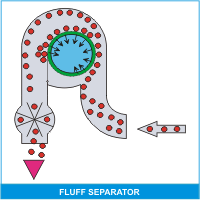
Operation of the separators
Separators can operate in a number of different ways, as outlined below.
Discharge air operation
When operating only in discharge air mode, all of the separating air is collected from outside and leaves the separator as discharge air. This requires appropriate discharge air treatment, such as via a filter or something similar. Control is effected through the discharge air fan, which is the only fan in the system.
Partial discharge/recycled air operation
The separator air comprises recycled air and aspiration air sucked into the system. The discharge air corresponds to the aspiration air which is ejected from the system. In this case, an appropriate air treatment is also necessary but generally on a much smaller scale than that required for discharge air operation. Control is effected through the recycled air fan. A second fan is required to handle the discharge air.
Recycled air operation
In this operating mode, all the separating air functions as recycled air. There is no discharge air and, therefore, discharge air treatment is not required. However, there is a need for an air-lock to discharge the heavy fraction from the separator housing because, without it, unwanted air would enter the system. A disadvantage of this process is the concentration of undesirable elements in the separating air, such as humidity and dust. Control is effected through a single fan, namely the recycled air fan.
Counter-flow separator/zig-zag windsifter
The zig-zag windsifter consists of a multi-deck zig-zag channel. Material is fed in from above and, in accordance with the laws of gravity, drops through the upward-flowing air-stream. Light and fine parts are captured by the air and entrained upwards, while large and heavy components are discharged at the base of the separator channel. Light and fine particles are removed at the top of the separator channel along with the separating air.
The zig-zag shape allows material to slide downwards, passing across the upward-flowing air stream from one deck to the next, where it is dispersed through impact for effective cleaning of clinging or tangled material.
So-called eddy-rolls are produced in the deflections of the separator channel where secondary separation of the material is carried out and turbulent flows are smoothed. Thus, these function as so-called turbulence grids.
An appropriate dwell time of the material being treated is ensured, which means precise separation results can be obtained. The separating criterion is the air velocity in the channel itself, which can be kept constant over a relatively large separating range because the separator channel guides and sets the limits of the air stream.
Ventilatorenfabrik Oelde has developed the following pair of zig-zag separators:
Zig-zag metal-cleaning windsifter WS
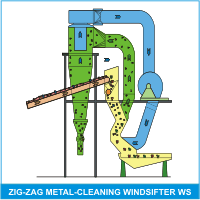
This robustly-designed ferrous/non-ferrous windsifter is used downstream of large shredders to clean shredded car bodies or mixed scrap. This screening task is fairly simple because the difference in density between the products to be separated is relatively large. Thus, the ferrous/non-ferrous windsifter has only one-and-a-half separating decks. Crucially, these separators have a very large throughput of up to 250 tonnes per hour, giving units with channel cross-sections of 1.6 x 1 metres. The volumetric flow of air moved in such a separator at a separating velocity of 22 metres per second is therefore 130 000 m³/hour.
Zig-zag windsifter ZWS
A zig-zag windsifter with at least four decks is used to sort material whose density is not so disparate, for example, when sorting plastics or waste or secondary fuel from refuse. This material has a low density but its volume in the sifter is nevertheless rather large. In this instance, separating channels with a cross-section of 1.2 x 0.8 metres can be used. The separating velocity is 10 metres per second or lower, meaning that flow rate is limited to around 40 000 m³/hour.
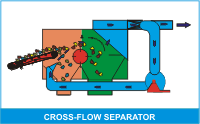 Cross-flow separator
Cross-flow separatorWith the cross-flow separator, material is fed into the housing via a conveyor belt and blown from below using a blast nozzle. Heavy material falls from the belt and is almost unaffected by the air-flow, whereas the light fraction is captured by the air-flow and transported into the fluff plenum over the rotating drum. The air is separated from the fluff and returned to the blast nozzle via the fan.
Since the blast air enters the separator housing as a free-flow jet, a large amount of ambient air is also sucked in which must be ejected from the system. Therefore, cross-flow separators can operate only with a recycled air content of up to 60%. The drum serves to stabilise the air-flow and increase separation quality, acting as an aerofoil for the air-flow and helping to concentrate the air-flow over a longer period. Through its rotation, it also transports the damp fluff striking the drum to the fluff plenum.
This equipment can be used to separate light packaging out of the so-called 'green bin' to generate a glass fraction with a purity of better than 98% at an hourly throughput of 2.5 tonnes using 1 metre wide equipment. This equipment can have an infeed width of up to 1.6 metres and is capable of handling 25 tonnes per hour, depending on the type of material.
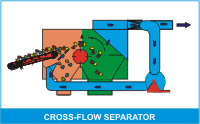

关注万迪欧德公众号

万迪欧德抖音号
Copyright © 2022-2023 Venti Oelde (Jiangsu) Air Handling Equipment Co. Ltd All Right
备案号:ICP 2023002554 技术支持:镁诚科技